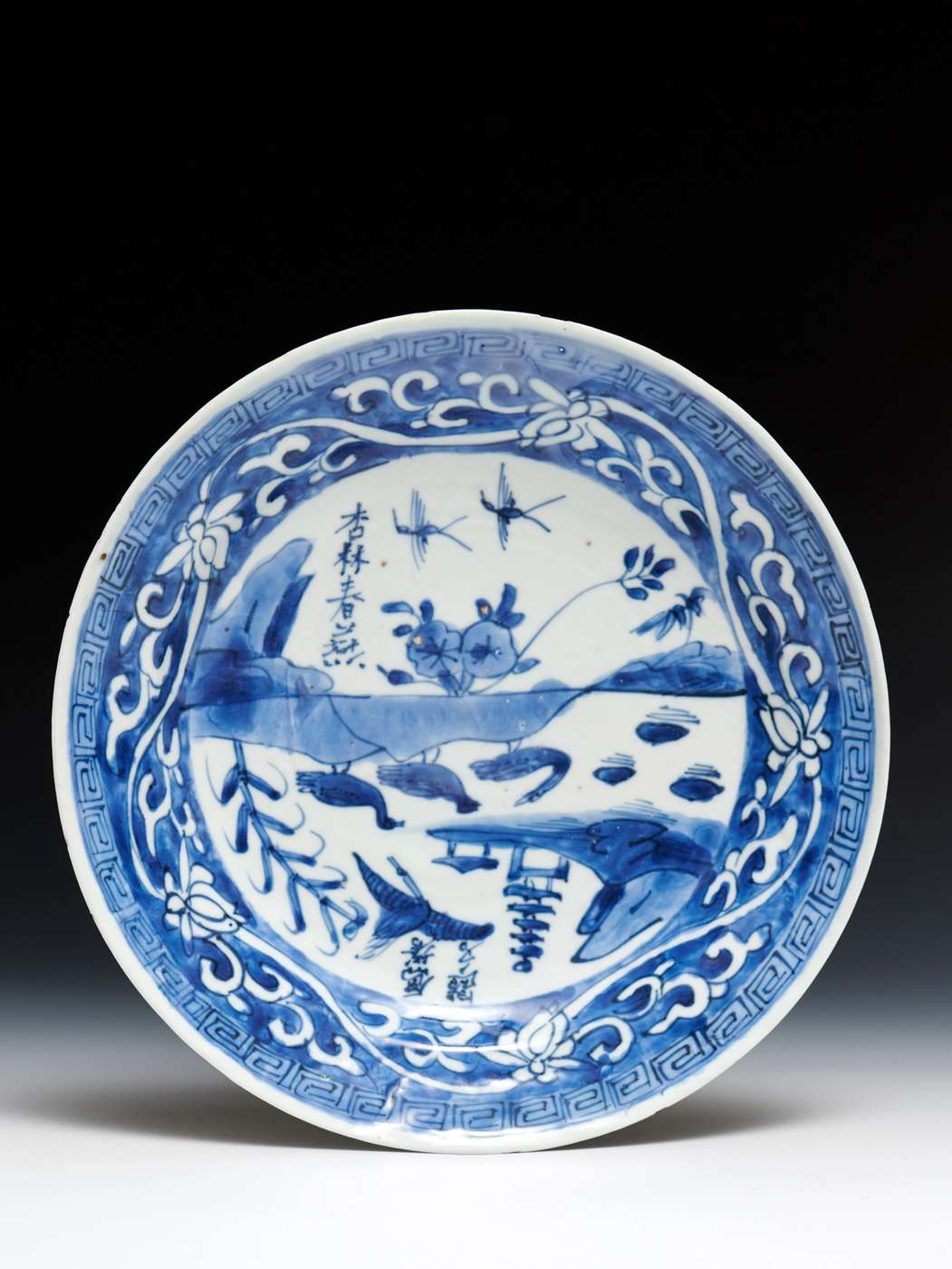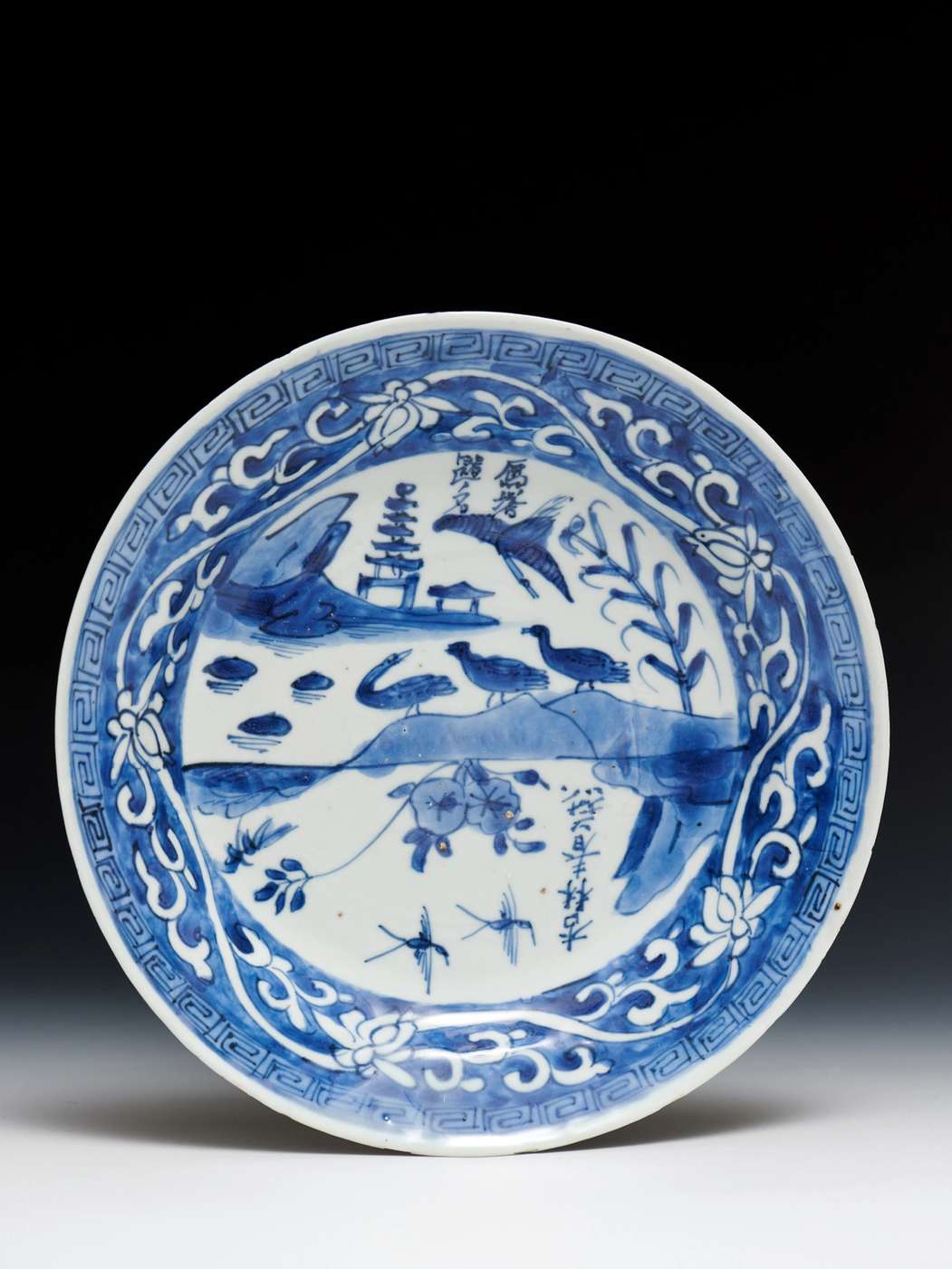Click the above image to zoom
Chinese porcelain plate decorated in underglaze cobalt blue (qinghua), the centre divided in two halves, the top shows a pagoda, geese, a lake and a four-character inscription, the bottom part an upside-down scene with flowers, birds and another four-character inscription, Tianqi/Chongzhen reigns, Ming dynasty.
Stock Number: 5190
Rare Chinese porcelain plate decorated in underglaze cobalt blue (qinghua) on the rim and cavetto under a Greek key an unusual “negative” lotus scrolling, the centre divided in two halves, the top shows a pagoda, geese, a lake and a four-character inscription, the bottom part an upside-down scene with flowers, birds and another four-character inscription, c. 1625, Tianqi/Chongzhen reigns, Ming dynasty, d. 21,5 cm, 8½ in. 1-19375
Literature:
• Late Ming, Chinese Porcelain from the Butler Family Collections, by Sir Michael Butler, Luxembourg, 2008, page 67 for a plate with identical inscriptions;
• Seventeen Century Chinese Porcelain from the Butler Family collection, by Sir M. Butler, M. Medley and S. Little, 1990 Art Services International, p. 51, cat. 13 for a similar plate but without the inscriptions.
◆ Translator’s notes: the four-character inscription on the upper half reads yan ta ti ming, (May your name be inscribed on the wall of the Yan Ta Pagoda). Yan Ta (Wild Goose Pagoda, now located in Ci’an temple in Xi’an city), is one of the signature buildings in Chang’an, the capital city of Tang Dynasty (618-907). During Tang Dynasty after the Imperial Examination, all the highest rank candidates - Jinshi inscribed their names, hometowns and dates on the wall of Yan Ta.
The second four-character inscription on the bottom half reads xin lin chun yan (May you enjoy the imperial spring banquet in the apricot grove). Apricot grove in Chinese is pronounced as xin lin, spring is pronounced as chun, swallow and banquet share the same pronunciation in Chinese – yan. This phrase is also related to the Imperial Examination. After taking the exam and before leaving for Yan Ta, the Jinshi candidates were invited to the imperial banquet held at the apricot grove in Qujiang, Chang’an.
Both phrases are commonly used in China as best wishes for students and wish them great academic achievements.
稀有的中國青花陶瓷盤,盤沿飾有希臘迴紋圖案,搭配一圈罕有的陰印纏枝蓮紋,盤中央畫片分為兩半:上部畫片飾有寶塔、湖泊與鵝,題有「雁塔題名」四字;下部顛倒畫片為花鳥圖紋,題有「杏林春燕」四字,約1625年,明天啟/祟禎,直徑21.5厘米,8½英寸。
參考文獻:
• 《Butler家族收藏的明末中國瓷器》,作者M. Butler爵士,2008年盧森堡出版,參見第67頁相同銘文;
• 《Butler家族收藏的十七世紀中國瓷器》,作者M. Butler爵士、M. Medley及S. Little爵士,1990年國際藝術服務公司出版,參見第51頁編號13一類似的盤子,惟沒有銘文。
◆ 譯者註:上半部分的四字銘文為「雁塔題名」。雁塔(現位於西安市慈安寺),是唐朝(618-907年)首府長安的標誌性建築之一。唐代科舉時期的新科進士都會在雁塔的牆上寫下了他們的名字、故鄉和日期。下半部分的四字銘文顯示為「杏林春燕」。燕諧音為「宴」,合為「杏林春宴」。新科進士在前往煙塔之前,會參加了在長安曲江杏樹園舉行的皇家宴會。兩句銘文均為勉勵學生,祝福學習優秀。
•



